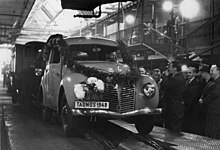
The Ford Taunus is a family car that was sold by Ford Germany throughout Europe. Models from 1970 onward were built on the same basic construction as the Ford Cortina MkIII in the United Kingdom, and later on, the two car models were essentially the same, differing almost only in the placement of the steering wheel. The model line was named after the Taunus mountain range in Germany, and was first made in 1939, and continued through several versions until 1994.

The Ford Eifel is a car manufactured by Ford Germany between 1935 and 1940. It initially complemented, and then replaced, the Ford Köln. It was itself replaced by the Ford Taunus.

The Ford Sidevalve is a side valve from the British arm of the Ford Motor Company, often also referred to as the "English Sidevalve". The engine had its origins in the 1930s Ford Model Y, and was made in two sizes, 933 cc (56.9 cu in) or "8 HP", and 1,172 cc (71.5 cu in) or "10 HP". The early engines did not have a water pump as standard, instead relying on thermosiphon cooling as the Model T engine had. A water pump was added in 1953 for the 100E models when the engine was re-engineered to the point that few specifications are identical between the early and the later series. The Sidevalve engine was used in many smaller Fords as well as farm vehicles, commercial vehicles and a marine version in boats. Production of the engine was stopped in 1962. Windscreen wipers were often driven by the vacuum generated in the inlet manifold.

The Mercedes-Benz W136 was Mercedes-Benz's main line of inline-four cylinder motorcars from the mid-1930s into the 1950s. The model 170 V made its public debut as successor to the W15 Typ 170 in February 1936. Between 1936 and 1939 it was Mercedes' top selling model.

Ford-Werke GmbH is a German-based car manufacturing factory headquartered in Merkenich- Cologne, North Rhine-Westphalia. It is a fully owned subsidiary of American Ford Motor Company, which operates two large manufacturing facilities in Germany, a plant in Cologne and a plant in Saarlouis and serves as a major hub for the Automaker's presence in the European markets.

The Adler Diplomat is a substantial six-cylinder “limousine” (saloon) built by the Frankfurt auto-maker, Adler. It was introduced in March 1934 as a direct replacement for the manufacturer's Standard 6. Less directly the six-cylinder Diplomat also replaced the Adler Standard 8 since Adler's large eight-cylinder car was discontinued in 1934 without a direct replacement of its own.

Initially presented early in 1933, the Audi Front UW 220 was Europe’s first car to combine front-wheel drive with a six-cylinder engine. It remained in production for slightly under two years before being replaced by the Audi Front UW 225 featuring a larger 2.25-litre engine. The larger-engined car introduced in 1935 was built till April 1938 and continued to be listed into 1939. Between 1933 and 1938, the Front was the only Audi in volume production.

The Ford Taunus P1 is a small family car which was produced by Ford Germany from 1952 until 1962. It was marketed as the Ford Taunus 12M, and, between 1955 and 1959, as the larger-engined Ford Taunus 15M. The company produced a succession of Ford Taunus 12M models until 1970, as the name was applied to a succession of similarly sized cars, but the first Taunus 12M models, based on the company's Taunus Project 1 (P1), remained in production only until 1962. In that year the Taunus P1 series was replaced by the Taunus P4 series.
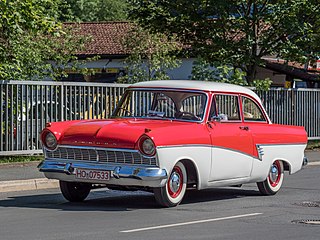
The Ford Taunus 17 M is a middle sized family saloon/sedan that was produced by Ford Germany between August 1957 and August 1960. The Taunus 17M name was also applied to subsequent Ford models which is why the car is usually identified, in retrospect, as the Ford Taunus P2. It was the second newly designed German Ford to be launched after the war and for this reason it was from inception known within the company as Ford Project 2 (P2) or the Ford Taunus P2.

The Ford Taunus 17 M is a middle sized family saloon/sedan that was produced by Ford Germany between September 1960 and August 1964. The Taunus 17M name had been applied to the car's predecessor and it would apply also to subsequent Ford models which is why the 17M introduced in 1960 is usually identified, in retrospect, as the Ford Taunus P3. It was the third newly designed German Ford to be launched after the war and for this reason it was from inception known within the company as Ford Project 3 (P3) or the Ford Taunus P3.

The Ford Taunus 12M is a small family car that was produced by Ford Germany between September 1962 and August 1966.
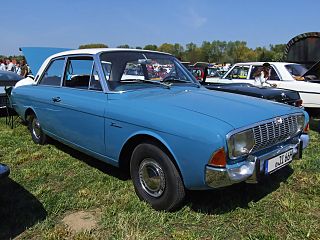
The Ford Taunus 17 M is a middle-weight family saloon/sedan that was produced by Ford Germany between 1964 and 1967. The entire range was first presented in September 1964 and volume production of the two and four door saloons/sedans began in November 1964. The "Turnier" version followed in January 1965 with coupé bodied cars coming along some time later.
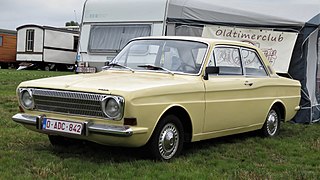
The Ford Taunus 12 M is a range of large family saloons/sedans that were produced by Ford Germany between 1966 and 1970. There were two different engine sizes in the 12M. Two larger engines were available in the otherwise very similar Ford Taunus 15 M. From the outside the 15M was differentiated by its grill and rectangular headlights from the 12M which had round front lights. A complicating feature was the availability, at extra cost, of one of the larger engines from the 15M in the 12M.
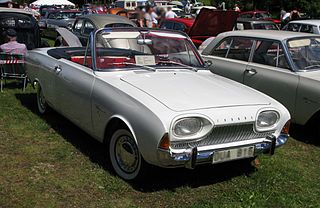
Karl Deutsch GmbH was a coach building firm known, in its later years, for converting mainstream motor cars into cabriolets. The business was located in Köln-Braunsfeld, a district on the west side of what today would be defined as central Cologne.
The Audi Type K was a car introduced by Audi at the Berlin Motor Show in September 1921. Since the end of the war Audi had till now produced only cars of pre-war design, so that the Type K was the first post-war Audi design to be offered. The Type K entered production in 1922 and was withdrawn in 1925, by which time the company had commenced production, in 1924, their Type M model which can be seen as a larger replacement for the Type K. The Audi Type K was the first volume produced car in Germany to feature left-hand drive.

The Audi Type SS was a large, eight-cylinder-powered sedan/saloon car introduced by Audi in 1929 in succession to the Type R "Imperator".

The Adler 2.5-litre was a sensation when first presented by Adler at the Berlin Motor Show early in 1937, although this did not convert into correspondingly sensational sales.

The Adler Primus is a small family car introduced by the Frankfurt based auto-maker, Adler in March 1932. In a move reminiscent of British Leyland in the 1970s, Adler launched two similarly sized cars in the same year, one of which followed the then new trend set by DKW for front-wheel drive, and one respecting the conventional rear-wheel drive configuration still used by the market leader, Opel.

The Adler Trumpf is a small family car introduced by the Frankfurt based auto-maker, Adler in March 1932, with Trumpf production fully starting in the late summer that year. In a move reminiscent of British Leyland in the 1970s, Adler launched two similarly sized cars in the same year, one of which followed the 1931 DKW F1's then innovative front-wheel drive layout, and the other model using the conventional rear-wheel drive configuration still used by then market leader, Opel's 1.2 litre 'model 6'.

The Ford Rhein is a truck model that Ford Germany manufactured together with its smaller sister model Ford Ruhr between 1948 and 1951.


